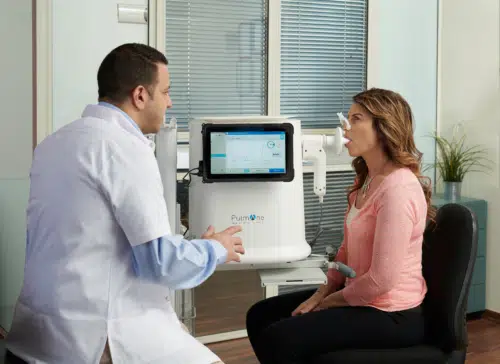
Pulmonary Function Tests
These tests help your provider diagnose and monitor asthma symptoms by measuring your overall lung health.
learn moreMost people with asthma, about 60-90%, have allergic asthma. Nonallergic asthma is less common, occurring in 10-40% of the people with asthma.
*According to The National Institute of Health (NIH).
Condition content was medically reviewed by an AllerVie Health physician in April 2023.

Nonallergic asthma is called intrinsic because it’s not caused by an allergen or something your body views as “foreign.” Extrinsic asthma is allergic asthma and is triggered by something in your environment that is outside of your body.
You can have allergic asthma and nonallergic asthma. Both types of asthma have the same symptoms. The difference is in what causes or triggers the asthma and how it is treated.
Nonallergic (intrinsic) asthma is different from allergic asthma. It is not triggered by allergens but is in fact caused from recurrent infections of the upper and lower respiratory tract. You can have allergic asthma and nonallergic asthma. The difference is in what causes or triggers the asthma and how it is treated.
The symptoms for nonallergic asthma and allergic asthma are the same. They include:
Asthma, all types, cause inflammation that narrows your airways and makes it difficult to breathe. Your body also produces excess mucus which makes it even harder to breathe.
Nonallergic asthma is caused by things that are not allergens like:
These causes contribute greatly to the severity of the symptoms:
When should you see an allergist for nonallergic asthma?
As with any type of asthma, you should see an AllerVie Health specialist if you are experiencing any of the symptoms of asthma and nonallergic asthma that are listed above.

Nonallergic asthma can be more severe than other types of asthma, like allergic asthma. Nonallergic asthma does not always respond to standard treatments for asthma.
People with nonallergic asthma make up about one third of all the people with asthma.
Typically occurs later in life
More prevalent in women
If you visit an allergist with asthma symptoms, he or she will first test you for allergic asthma. This can include a thorough discussion of your medical history, testing for respiratory infections as well as the below tests. If your asthma is not triggered by allergens the specialist will look to other factors that may be causing your asthma.

Pulmonary Function Tests
These tests help your provider diagnose and monitor asthma symptoms by measuring your overall lung health.
learn more
Skin Allergy Testing
This is less invasive than blood tests and is a good alternative for patients who don’t like needles.
learn moreTreatment for nonallergic asthma will depend on the triggers. Treatments typically include medications, lifestyle changes and the avoidance of triggers. Following are categories of nonallergic asthma treatments that may be prescribed or recommended by your doctor.
Medications
Inhaled corticosteroids and bronchodilators are commonly used to control the symptoms of nonallergic asthma. These medications work by reducing inflammation and opening up the airways.
Breathing exercises
Breathing exercises such as pursed-lip breathing, diaphragmatic breathing, and yoga can help improve lung function and reduce asthma symptoms.
Avoid triggers
Identify and avoid triggers that can cause an asthma attack.
Maintain a healthy weight
Maintaining a healthy weight can help improve lung function and reduce asthma symptoms.
Stress managment
Stress can trigger asthma symptoms in some people. Techniques such as mindfulness meditation, deep breathing, and progressive muscle relaxation can help manage stress and reduce asthma symptoms.
Following the recommendations of your doctor can help you live an active life and keep your asthma under control. When you have nonallergic asthma that is caused by an underlying infection, it is especially important to follow your asthma management plan to keep your condition from becoming chronic and uncontrolled.